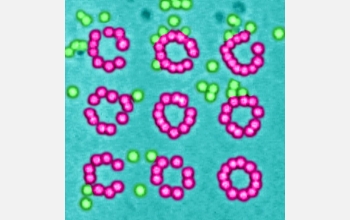Multimedia Gallery
Colloidal silica spheres dispersed in water
A false-colored video micrograph of colloidal silica spheres dispersed in water and organized into a micrometer-scale mixer by torque-exerting optical traps known as optical vortices.
This research (and earlier stages of its development) was supported by the National Science Foundation's Materials Research Science and Engineering Centers Program. Additional funding was also provided by the W.M. Keck Foundation and by a grant from Arryx Inc. (an industrial partner).
More about this image
The 3 x 3 array of optical vortices shown here was created with a computer-designed hologram and projected with the same microscope objective lens used to create the image. Each optical vortex is a ring of intense laser illumination that captures mesoscopic objects with optical gradient forces. Once trapped, the particles are subjected to torques exerted by the orbital angular momentum carried by the specially prepared beams of light. The particles in each ring circulate at up to 1000 revolutions per minute (RPM), generating hundreds of nanometer-scale flows in the surrounding fluid. Optical vortex arrays therefore act as optical assembled and actuated pumps and mixers in the mesoscopic domain.
Optical tweezers use the forces exerted by a strongly focused beam of light to trap and move objects ranging in size from tens of nanometers to tens of micrometers. Since its introduction in 1986, the optical tweezer has become an important tool for research in the fields of biology, physical chemistry and soft condensed matter physics. Recent advances promise to take optical tweezers out of the lab and into the mainstream of manufacturing and diagnostics; they may even become consumer products. The next generation of single-beam optical traps offers revolutionary new opportunities for fundamental and applied research. (Year of image: 2001)
Credit: ©2001, D.G. Grier, New York University, J.E. Curtis and B.A. Koss. Further information is available at http://www.physics.nyu.edu/grierlab/hot.
Images and other media in the National Science Foundation Multimedia Gallery are available for use in print and electronic material by NSF employees, members of the media, university staff, teachers and the general public. All media in the gallery are intended for personal, educational and nonprofit/non-commercial use only.
Images credited to the National Science Foundation, a federal agency, are in the public domain. The images were created by employees of the United States Government as part of their official duties or prepared by contractors as "works for hire" for NSF. You may freely use NSF-credited images and, at your discretion, credit NSF with a "Courtesy: National Science Foundation" notation.
Additional information about general usage can be found in Conditions.
Also Available:
Download the high-resolution JPG version of the image. (384 KB)
Use your mouse to right-click (Mac users may need to Ctrl-click) the link above and choose the option that will save the file or target to your computer.



